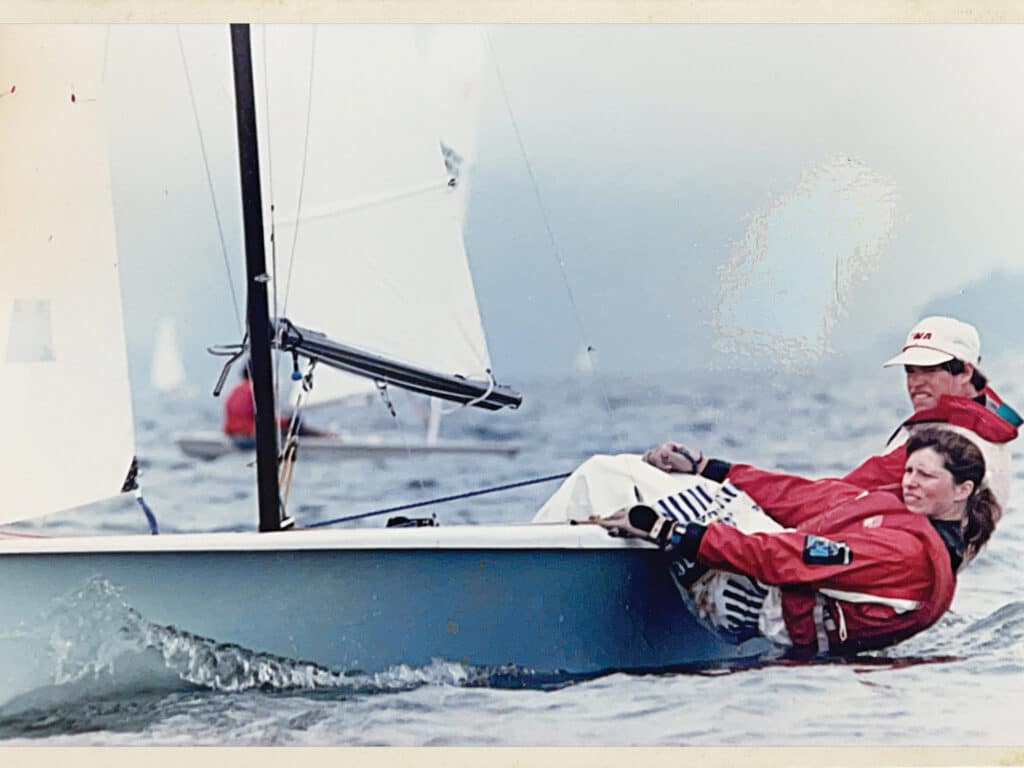
When I tell people my husband and I race competitively together in a two-person dinghy, the usual response is something like, “No way! We’d be divorced,” or “That would be a marriage-ender for us.” While I completely understand this sentiment, for Jonathan and me, it’s been just the opposite—a marriage-builder. We came to sailing together as part of our courtship, and it’s a foundational piece of our life together. I sailed Lasers and 470s at the national and international levels in the 1980s and, of course, Jonathan was pretty accomplished himself. Our first regatta together was the US Tasar North Americans in 1988, which started a 35-year relationship with the class and racing as a team. Since then, in addition to many local regattas, we’ve sailed eight Tasar World Championships, winning four, and finishing second in three and fifth in one. In January, we’ll be heading to the 2024 Tasar Worlds in Melbourne, Australia.
To state the obvious, sailboat racing is intense, especially dinghy sailing. It’s physically demanding and mentally challenging, and not every day goes as planned. On those days, things can get a bit strained, which can be tough on a relationship. Like any team, we each have our roles. Jonathan steers, trims the main and calls tactics. I manage the weight, hike, and adjust the forward controls while talking about the wind, compass, course and the other boats. On those days when things are not going well, my responsibility is also to stay positive, be forward-thinking, and convey confidence in him—and in us as a team. I work to feed him useful information so he can make the very best next decision and the one after that.
At a regatta some time ago, we found ourselves in the bottom third of the fleet, rounding the leeward mark of the first downwind leg. Our spirits were already low when the mainsail clew shackle gave way. After a quick repair, and the fleet sailing away from us, Jonathan looked deflated and asked, “Now what?” I immediately responded, “We’re racing!” And off we went to rejoin the race as best we could. Racing every minute until the very end of every race is something I had learned from him in the past, so I gave it back at the right moment.
Crews in doublehanded boats are often underappreciated. It’s assumed skippers do everything, with crews taking orders. At the top of the fleet, that simply doesn’t deliver winning results over time. But it’s hard to see what top crews are doing differently. Success begins with confidence in your skills as a sailor and as an equally important part of the team, even if you don’t have your hand on the helm. It also blends opposing concepts: equal partnership with a hierarchy of tactical decision-making; separate roles in the boat combined with synchronicity of movement and boathandling; being of service to one’s skipper but not subservient. Practicing these concepts in addition to the normal things like starting, speed tuning and maneuvers makes them second nature and accessible during the intensity of a race.
Some time ago, I realized I can communicate disappointment or doubt from the front of the boat without saying a word. Needless to say, this vibe is not great for skipper confidence, results or the dinner table. Since then, I consciously set an intention to emanate support and belief in Jonathan regardless of what’s happening in the race because I know he’s already putting in 110 percent for our success.
The 2022 Worlds was a real test for our partnership. Jonathan’s sister had died suddenly a month before the regatta, and during the lay day, his mom passed away after a long illness. Hearts broken, we leaned into our sailing community and the comfort of racing together for support and healing. The tone in the boat was different. We were still focused on competing with excellence, but it came with a halo of gentleness and an awareness that the friends and family who surround our lives and our sailing are what really matter.
Over the years, I have begun to see sailing with Jonathan as a way to increase our mental and emotional alignment, with the goal of bringing out the very best in each other. We don’t always live up to our ideals in this regard, but the number of race days spoiled due to one of us being in a bad mood or letting our egos get in the way are increasingly few. Foundational to all this is respect for what the other brings to the team and a deep faith in the team itself. This inspires investment in getting better and working out the issues that inevitably arise when you’re part of something meaningful—like a marriage.









